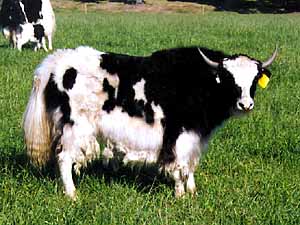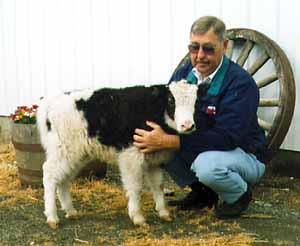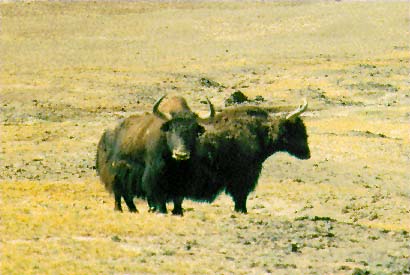
Welcome to the Wonderful World of Yaks

Here's some facts on our friend the Yak. If you want to see picts, click here.
ORDER: Artiodactyla
FAMILY: Bovidae
GENUS: Bos [Tibetan Yak]
SPECIES: grunniens
-------------------------------------------------------------------------------------------------------------------------
I. DESCRIPTION:
Blackish-brown with enormously long hair almost reaching the ground,
and continuing down the tail giving it a bushy appearance. A thick and
woolly undercoat lies under the long hair. Heavily built with drooping
head, high humped shoulders, straight back and short sturdy limbs.
Shoulder height about 5 feet 2 inches; weight up to 1500 pounds. The
large black horns curve upward and forward in males, and may measure 40
inches from tip to tip. Domestic yaks are smaller and are colored red,
mottled, brown or black.
II. GEOGRAPHICAL RANGE AND HABITAT:
Yaks live in the high bleak plateaus and mountains of central Asia.
They are found in Tibet, Kansu (northwest China), and the Chang Chenmo
Valley of Ladakh (eastern Kashmir). Their range is from the lower
valleys to 20,000 foot levels. In the winter the wild yak moves from
the snow-covered slopes to the valleys. These animals do not thrive in
the lower and warmer parts of Asia.
III. DIET:
Coarse grasses, herbs, and lichens.
IV. LIFE CYCLE/SOCIAL STRUCTURE:
Bulls wander alone or in small groups but females and calves herd
together for protection. During the mating season in late fall or early
winter, each male forms a small herd of four or five females. About
nine or ten months later the females give birth to a single calf.
Independence is attained after 1 year of life, full size is reached at
6-8 years, and maximum life span is 25 years.
V. SPECIAL ADAPTATIONS:
The yak is exceptionally well adapted to endure cold and shows superb
stamina, which makes it an excellent animal for carrying people and
other burdens. In spite of their awkward appearance, yaks are excellent
climbers, surefooted and sturdy.
VI. INTERPRETIVE INFORMATION:
In Tibet these animals have been domesticated for centuries and are
quite docile. Although used principally for transportation, they are
valued also for their meat which is of excellent quality. The cows
provide quantities of rich milk. Tibetans also extract good yields of
butter, which is stored in hide bags and is used to flavor tea or is
burned in religious shrines. The long hair of the yak is made into
ropes, while hides with hair are used as covering for tents. Only
castrated males are called yaks; a bull is a "boa" and a cow is a
"dri". There are about 12 million domestic yaks though only a few
hundred wild ones.
VII. STATUS IN WILD:
The wild yak is classified as endangered by the IUCN (1974) and the
USDI. Although officially protected in China, uncontrolled hunting has
caused populations to decline drastically. Numbers were estimated to be
only a few hundred in 1987.
VIII. BIBLIOGRAPHY:
1. National Geographic, June, 1989.
2. Nowak, Ronald and John Paradiso. 1983. Walker's Mammals of the
World, 4th Edition. The John Hopkins University Press.
AC:92
This is the site I got my Yak info from- check it out for more pictures, and facts on you guessed it- yaks....
Isn't she a beauty?

A boy and his yak. Very touching.

Not much to say about this one. Let's just make a yak noise, ok?

Let's take a minute to enjoy their wild beauty.
